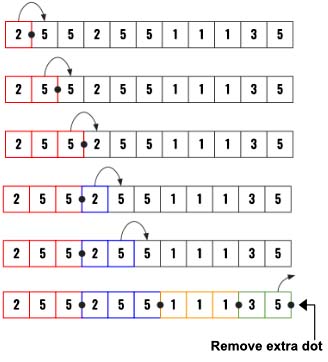Backtracking - Restore IP Addresses
All diagrams presented herein are original creations, meticulously designed to enhance comprehension and recall. Crafting these aids required considerable effort, and I kindly request attribution if this content is reused elsewhere.
Difficulty : Easy
DFS
Problem
A valid IP address consists of exactly four integers separated by single dots. Each integer is between 0 and 255 (inclusive) and cannot have leading zeros.
- For example,
"0.1.2.201"and"192.168.1.1"are valid IP addresses, but"0.011.255.245","192.168.1.312"and"192.168@1.1"are invalid IP addresses.
Given a string s containing only digits, return all possible valid IP addresses that can be formed by inserting dots into s. You are not allowed to reorder or remove any digits in s. You may return the valid IP addresses in any order.
Example 1:
1
2
Input: s = "25525511135"
Output: ["255.255.11.135","255.255.111.35"]
Example 2:
1
2
Input: s = "0000"
Output: ["0.0.0.0"]
Example 3:
1
2
Input: s = "101023"
Output: ["1.0.10.23","1.0.102.3","10.1.0.23","10.10.2.3","101.0.2.3"]
Solution
Here is the high level idea on how to solve the problem.
Use DFS
From every char recursively call up to max 3 next char for possible combinations ( unless end has reached ).
Need to validate for leading “0” numbers however 0 is an allowed number in ip.
Remove the extra dot added at the end.
Let’s solve this step by step. Start with the edge cases. If the string length is more than 12 then this can not be a valid IP address.
1
2
3
4
output = []
if len(s)> 12:
return output
Now start the dfs(). How do we even find out what parameter to pass in the dfs() function ?
- At least we know that we need to move forward in the string, so
indexshould be one parameter. - We also know number of
dotsneed to be tracked as having more than4dots invalidates the current traversal. So, let’s passnum_dotsas well. - Finally, different path we take will create a new ip, so for every path of have its own
ipwe need to pass thecurrent_ipas well.
Let us start with these three and we can add more if needed later.
1
2
def dfs(index, num_dots, current_ip):
...
The first think we need to define is the base/terminating condition so that we can terminate current path progression. This can have multiple parts some for successful completion and some for stopping as we know for sure that valid result won’t be possible to be achieved in this path.
Successful condition
Let’s start with successful completion criteria. We know that if the index has reached the end of the string and we have exactly 4 dots then we know that we have a valid ip.
Question - Why 4 dots when the ip needs only 3 ?
Answer - The 4th dot confirms that the last segment of the ip after 3rd dot is a valid segment. For an example if we have a string "25525511100", then we know 255.255.111.00 is not a valid ip even if it has 3 dots.
Make sure to remove the extra 4th dot before appending it to the output array.
1
2
3
if num_dots == 4 and index == len(s):
output.append(current_ip[:-1])
return
Terminating condition
Now is there a terminating condition. You will soon find that if num_dot>4 but index < len(s) then the current_ip can not be a valid ip. So we need to return without adding it to the output.
1
2
if num_dots > 4:
return
Traversal
From every index position we should open 3 paths forward and explore all possible combinations for all possible valid ip. Here is the example of how that might look for the above example.
So in every dfs() call we need to have a for loop to call dfs() 3 more times. There just only one edge condition, what if there are less then 3 numbers available at the end of the string. So we need to always make sure we to consider the chars we have up to 3.
In the example above, whenever we are at 3 (green segment), we won’t be having 3 more char to look at. So we have to take range(index ,min(index+3, len(s))) = range(9, min(9+3, 11)) = range(9,min(12,11))= range(9,11) and progress accordingly.
1
2
for j in range(index, min(index+3, len(s))):
val = s[index:j+1]
We have to perform some more validations before we can invoke dfs()
- Ip number’s segments are always between
0and255 - There can not be leading
0
We can’t run dfs() if any following two validations are passed.
1
2
if int(val) > 255 or (len(val)>1 and val[0]=="0"):
continue
Invoke the dfs(), we need to pass the next index from j, so increment j by 1. We have increment num_dots as well as we are going to update current_ip by appending val and ..
1
dfs(j+1, num_dots+1,current_ip+val+'.')
We are near end now. Just invoke the dfs() and return output.
1
2
dfs(0,0,'')
return output
Final Code
Here is the full code.
1
2
3
4
5
6
7
8
9
10
11
12
13
14
15
16
17
18
19
20
21
22
23
24
def restore_ip_addresses(s):
output = []
if len(s) > 12:
return output
def dfs(index, num_dots, current_ip):
if num_dots == 4 and index == len(s):
output.append(current_ip[:-1])
return
if num_dots > 4:
return
for j in range(index, min(index+3, len(s))):
val = s[index:j+1]
if int(val) > 255 or (len(val) > 1 and val[0] == "0"):
continue
dfs(j+1, num_dots+1, current_ip+val+'.')
dfs(0, 0, "")
return output


